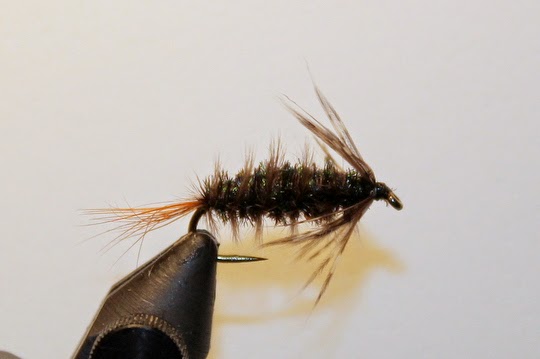The Isonychia bicolor (Slate Drakes) mayfly is arguably as important as the famed Yellow Sallies that everyone is trying to match. The interesting thing about this hatch is that, at least in many places, the nymph is the only important stage that fishermen need concern themselves with. One very notable exception to this is the Hiwassee River where the duns emerge mid stream and fishing from a drift boat can produce excellent action during the hatch. However, on the mountain streams, Isonychias generally crawl out onto the rocks in and around the stream and hatch out of the water. That means the fish rarely see a dun and the spinner falls are only rarely important, at least during legal fishing hours.
Earlier this week, I found large quantities of shucks on one of my local smallmouth bass streams and eventually a gorgeous dun that was still sitting on the rock it hatched on. Here, you can see the shucks where the nymphs crawled out of the water to hatch. The second picture is a newly hatched dun.
These are large bugs, often a size #8 or #10 and the fish react accordingly. In the Smokies, trout will often take a nymph imitation when nothing else is seeming to work. In fact, one of the better brown trout I caught last summer ate my own Isonychia pattern.
If you don't have your own secret pattern, a Prince nymph does a reasonably decent job at imitating these bugs as well as a variety of commercially available Isonychia nymphs that you should be able to find at your local fly shop. Want to take a stab at my favorite, an Isonychia Soft Hackle? Here is a picture and a recipe.
David Knapp's Isonychia Soft Hackle
Hook: #8-#12 TMC 5262 or 3671 (I use mostly #10-#12)
Weight: .020 Lead-free wire
Thread: Black 8/0
Tail: Brown hackle fibers
Body: Several strands of peacock fibers, twisted together for durability
Rib/Gills: Gray ostrich herl
Back/Stripe: Pearl or silver Flashabou or small pearl tinsel
Hackle: Speckled Brown Soft Hackle Hen Saddle patch feather (2-3 turns)
Tying directions: Add wire first and then start thread and cover the wire with a thread base. Tie in tail and then flash. Tie in ostrich and then peacock herl. Wind peacock herl forward, adding more if you need it to get a nice full body. Tie off. For added durability, wind thread back and forth over body several times. The thread will bite into the herl and should be mostly invisible but it will help hold the body together once fish start chewing on it. Next, palmer the ostrich herl forward and tie off. Pull flash strip over back and tie off behind the head. Finally, tie in soft hackle feather, wrap 2-3 turns depending on how thick the fibers are, and tie off. Whip finish and add a small drop of glue to the head and you are done!
How to fish
When fishing an Isonychia nymph pattern, you need to understand the naturals. The nymph is an active swimmer. This means that your normal dead drift is fine, but if that isn't working, try changing it up by adding a jigging motion with your rod tip or swinging the fly at the end of each drift. Some of the best trout that I've caught in the Smokies have come on an Isonychia nymph pattern so try one out this summer on the Little River or other larger Park stream and see if you agree that this is one of the most important hatches of the summer.






My favorite late summer/fall hatch in New England. Here they will take dunks but soft hackles also take lots of fish. I like your take on the soft hackle!
ReplyDeleteMark, let me know if you try that SH out up there. I'm curious if it is as effective elsewhere as it is here.
DeleteDavid
ReplyDeleteI am fishing soft hackles a lot more now, and having success with them on the Sipsey tailrace. Thanks for sharing
Bill, they are some of my favorite flies and I fish them in a wide variety of methods.
DeleteI remember seeing some crazy Isonychia hatches on the Hiwassee years ago. The Zug Bug was also a good pattern to use when the Isonychia hatch was taking place.
ReplyDelete